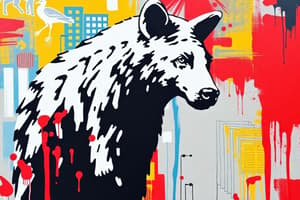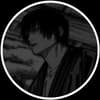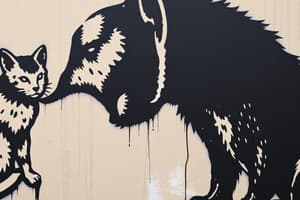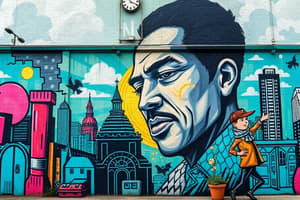Podcast
Questions and Answers
Considering Blu's artistic trajectory, which of the following best encapsulates the transformative aspect that legitimized his shift from illegal graffiti to commissioned murals?
Considering Blu's artistic trajectory, which of the following best encapsulates the transformative aspect that legitimized his shift from illegal graffiti to commissioned murals?
- The incorporation of overtly political messages in his murals, which resonated with the social commentary expected by modern art institutions.
- His transition to using rollers on telescopic sticks, which allowed for greater precision and detail in his artwork, thereby appealing to institutional commissioners.
- His adoption of colour in his murals, making them visually more appealing and thus commercially viable for various institutions and organizations.
- The acquisition of formal consent from property owners, coupled with a move towards larger, more planned formats, shifting his work from clandestine to sanctioned. (correct)
Juxtapose the removal of Blu's mural at the Deitch Gallery with the planned removal of his Warsaw mural. Which statement accurately assesses the underlying motives and ensuing community responses?
Juxtapose the removal of Blu's mural at the Deitch Gallery with the planned removal of his Warsaw mural. Which statement accurately assesses the underlying motives and ensuing community responses?
- The Deitch Gallery removal was rooted in censorship due to political content, whereas the Warsaw situation sparked community protest against perceived commodification of public art by the Theatre Institute. (correct)
- Both removals were driven by the artist's own dissatisfaction with the works, leading to minimal community protest.
- The Deitch Gallery mural was removed for aesthetic incongruity with the gallery's brand, while the Warsaw mural removal faced no opposition due to the artist's prior consent.
- Both incidents were primarily motivated by commercial interests, with the Deitch Gallery making room for more profitable exhibitions and the Theatre Institute seeking to promote its upcoming plays.
In the context of urban art conservation, how does the transient nature of murals, as discussed, challenge traditional art preservation paradigms advocated by building owners and city authorities?
In the context of urban art conservation, how does the transient nature of murals, as discussed, challenge traditional art preservation paradigms advocated by building owners and city authorities?
- The transient nature of murals reinforces traditional preservation paradigms, as building owners are compelled to invest in the regular upkeep and restoration of these artworks to maintain their aesthetic appeal.
- The transient nature of murals necessitates a shift from preservation to documentation, challenging the desire for control over aesthetics and prompting the consideration of murals as temporary interventions rather than permanent fixtures. (correct)
- The ephemeral nature of murals bypasses the need for preservation, as their impermanence negates any long-term conservation concerns for city authorities.
- The ephemeral quality of murals aligns perfectly with traditional preservation approaches, as regular restoration allows building owners to maintain their property's aesthetics.
How did the symbolic funeral of Blu's mural in Berlin encapsulate the broader socio-political anxieties of the city's residents following the fall of the Berlin Wall?
How did the symbolic funeral of Blu's mural in Berlin encapsulate the broader socio-political anxieties of the city's residents following the fall of the Berlin Wall?
To what extent does Blu's Warsaw mural, depicting soldier-marionettes adorned with currency symbols, serve as a critique of war and power dynamics, considering its location and the artist's broader thematic concerns?
To what extent does Blu's Warsaw mural, depicting soldier-marionettes adorned with currency symbols, serve as a critique of war and power dynamics, considering its location and the artist's broader thematic concerns?
How does Woynarowski's concept of a "theatrical eye" mural, intended to replace Blu's work, encapsulate the interplay between observer and observed, and how does this reflect the theme of public theatre's 250th anniversary?
How does Woynarowski's concept of a "theatrical eye" mural, intended to replace Blu's work, encapsulate the interplay between observer and observed, and how does this reflect the theme of public theatre's 250th anniversary?
Critically evaluate the Theatre Institute's decision to initially proceed with Woynarowski's mural despite widespread public opposition. What underlying assumptions about the nature and value of street art might have influenced their actions?
Critically evaluate the Theatre Institute's decision to initially proceed with Woynarowski's mural despite widespread public opposition. What underlying assumptions about the nature and value of street art might have influenced their actions?
Analyze the Vlep[v]net Foundation's critique of the planned replacement of Blu's mural with Woynarowski's, particularly focusing on their assertion that the latter represents an act of 'instrumentalizing artistic activity.' What are the key implications of this statement?
Analyze the Vlep[v]net Foundation's critique of the planned replacement of Blu's mural with Woynarowski's, particularly focusing on their assertion that the latter represents an act of 'instrumentalizing artistic activity.' What are the key implications of this statement?
How does the controversy surrounding the planned replacement of Blu's Warsaw mural reflect broader tensions between the ephemeral nature of street art and the desire for permanence expressed by urban communities and institutions?
How does the controversy surrounding the planned replacement of Blu's Warsaw mural reflect broader tensions between the ephemeral nature of street art and the desire for permanence expressed by urban communities and institutions?
Considering Tomasz Thun-Janowski's concerns about the lasting impact of the controversy on future street art initiatives in Warsaw, what are the potential ramifications for the city's urban art scene?
Considering Tomasz Thun-Janowski's concerns about the lasting impact of the controversy on future street art initiatives in Warsaw, what are the potential ramifications for the city's urban art scene?
Synthesize Artur Turowski's perspective on the graffiti covering the lower parts of Blu's mural in Warsaw. How does this viewpoint challenge conventional notions of art preservation and artistic integrity?
Synthesize Artur Turowski's perspective on the graffiti covering the lower parts of Blu's mural in Warsaw. How does this viewpoint challenge conventional notions of art preservation and artistic integrity?
In what ways does Mateusz Ściechowski’s assertion that street art 'does not necessarily have to be conserved' deconstruct the traditional museum-centric approach to art preservation and value?
In what ways does Mateusz Ściechowski’s assertion that street art 'does not necessarily have to be conserved' deconstruct the traditional museum-centric approach to art preservation and value?
Critically assess the city of Warsaw's stance on street art, as characterized by Tomasz Thun-Janowski, and how does their stated goal of ensuring the 'development of a variety of creativity' influence their approach to managing urban artistic interventions?
Critically assess the city of Warsaw's stance on street art, as characterized by Tomasz Thun-Janowski, and how does their stated goal of ensuring the 'development of a variety of creativity' influence their approach to managing urban artistic interventions?
Examine the implications of the collective voice of Warsaw's residents, who boycotted the Theatre Institute's decision, in the context of urban planning and civic engagement. How does this event reshape the dynamics between city authorities and the urban community?
Examine the implications of the collective voice of Warsaw's residents, who boycotted the Theatre Institute's decision, in the context of urban planning and civic engagement. How does this event reshape the dynamics between city authorities and the urban community?
Given the multifaceted perspectives presented, what comprehensive strategy could Warsaw adopt to effectively balance the preservation of iconic street art with the promotion of new artistic endeavors in urban spaces?
Given the multifaceted perspectives presented, what comprehensive strategy could Warsaw adopt to effectively balance the preservation of iconic street art with the promotion of new artistic endeavors in urban spaces?
Flashcards
Murals
Murals
Street art that is typically large-scale and painted on walls, often with permission.
Gentrification
Gentrification
The process where a neighborhood changes, often displacing current residents due to increased property values.
Who is Blu?
Who is Blu?
Blu is an Italian artist known for large murals with socially and politically charged messages.
Evanescent Nature of Murals
Evanescent Nature of Murals
Signup and view all the flashcards
Blu's Censored Mural in NYC
Blu's Censored Mural in NYC
Signup and view all the flashcards
Blu's Mural in Berlin (Cuvrystraße)
Blu's Mural in Berlin (Cuvrystraße)
Signup and view all the flashcards
Symbolic Funeral of Blu's Berlin Mural
Symbolic Funeral of Blu's Berlin Mural
Signup and view all the flashcards
Blu's Mural in Warsaw
Blu's Mural in Warsaw
Signup and view all the flashcards
Defense of Blu's Warsaw Mural
Defense of Blu's Warsaw Mural
Signup and view all the flashcards
Murals as Temporary Art
Murals as Temporary Art
Signup and view all the flashcards
Murals vs. Advertisements
Murals vs. Advertisements
Signup and view all the flashcards
Street Art
Street Art
Signup and view all the flashcards
Murals and Legacy
Murals and Legacy
Signup and view all the flashcards
Study Notes
- Warsaw, Łódź, and Kraków are competing to be Poland's street art capital.
Blu's Artistic Evolution
- Blu is famous for outdoor murals, video works, and animations online.
- He started as an illegal graffiti artist in Bologna in the late 1990s.
- Blu transitioned from spray paint to a roller on a telescopic stick to develop his unique style.
- His murals feature large human figures with details conveying messages tied to the painting's location or context.
- Enlarging the scale of his work and obtaining consent from building owners helped Blu legalize his art.
The Ephemeral Nature of Murals
- Murals are often considered temporary, subject to being painted over or deteriorating.
- They're frequently created on buildings with uncertain futures.
- Some murals become symbolic, leading to community protests when removal is attempted.
- Conservation of outdoor paintings is controversial; artistic circles don't always see the need or possibility of restoration.
- Building owners, often city authorities, desire aesthetic control over their property.
Instances of Censorship
- The first instance of a Blu mural being erased occurred in 2008 at the Deitch Gallery in New York due to its political content.
- Jeffrey Deitch, once an advocate for graffiti art, had the mural erased one day after completion, because it depicted coffins covered with dollar bills instead of American flags.
- Blu's most famous work, a two-part mural on Cuvrystraße in Berlin, was erased because it no longer matched the gentrified image of Kreuzberg.
- The Berlin murals were located near a former East-West Germany border checkpoint.
- One painting depicted a man with gold watch handcuffs, and the other showed two men tearing off masks to reveal "E" and "W" for East and West.
- Following a petition and consultation with Blu, Berliners held a symbolic funeral for the mural, painting it black to protest privatization policies that were displacing artists.
- Prior to this, another of Blu's murals in Berlin depicting an hourglass as a metaphor for global warming, was replaced by an advertisement.
The Warsaw Mural
- In 2010, Blu participated in the Updates festival in Warsaw.
- He created a mural on the Kamienica pod Żaglowcem featuring seven marionette-soldier figures with currency symbols adorning their helmets and uniforms.
- The mural represented Warsaw's history, as the building was one of the few not destroyed during the war, and highlighted war as a tool of those in power.
- It also marked one of Blu's first uses of color, with pale green uniforms.
- Blu was invited by the Vlep[v]net Foundation, and the Updates festival was curated by Mateusz Ściechowski (Miesto).
- Blu painted the mural over four days in July amid high temperatures, minimizing his breaks and remaining on the scaffolding.
Controversy and Defense
- Five years later, the wall's 1200 square meters were slated for a mural by Jakub Woynarowski, who represented Poland at the 14th Biennale of Architecture in Venice.
- The Zbigniew Raszewski Theatre Institute in Warsaw initiated the project to celebrate 250 years of public theatre in Poland.
- The Institute, after requesting wall space with Wojciech Wagner, wanted to commission murals centered around the theme "Przeżyjemy w teatrze" ("We Will Survive in the Theatre").
- Woynarowski's project was to depict a giant eye gazing from a theatre stage, inspired by Claude Nicolas Ledoux and René Magritte.
- The announcement stirred an uproar, with a Facebook boycott gaining over four thousand participants.
- The Theatre Institute released videos defending Woynarowski and the ephemeral nature of murals, which was criticised by the public and the Outer Art Foundation.
- The Theatre Institute released an official statement saying they contacted Fundacja Vlep[v]net and would document Blu's mural.
- Fundacja Vlep[v]net declared they were against the decision, appealed to preserve the mural, but could not administer the wall.
Resolution
- Public protest led the Theatre Institute to withdraw the project, keeping Blu's mural intact.
- Woynarowski's project was transferred to the public domain for other cities to bid on, with the Theatre Institute relinquishing the copyright.
- Critics viewed Woynarowski's proposed painting as an advertisement due to the inclusion of logos from the organizers, which was seen as inappropriate for the wall.
- Some saw the accusations of Woynarowski being a sell-out as misguided.
- The head of the city's Cultural Bureau expressed concern that the controversy would prevent future murals from being painted and that street artworks are not meant to function forever.
- Street and urban artists were unconcerned about Blu's mural ageing, and the mural was made with diluted paint to create this impression from the start.
- The Vlep[v]net Foundation viewed the addition of graffiti as a sign of a living street and community.
Reflections on Street Art in Warsaw
- Warsaw citizens demonstrated their identification with the city by defending Blu's work.
- The incident highlighted the need for dialogue between public institutions and the street and urban art community.
- Warsaw aims to foster a variety of creativity, including street art.
- The city of Warsaw acknowledged the need to develop standard procedures for street art initiatives to avoid conflict.
Studying That Suits You
Use AI to generate personalized quizzes and flashcards to suit your learning preferences.





